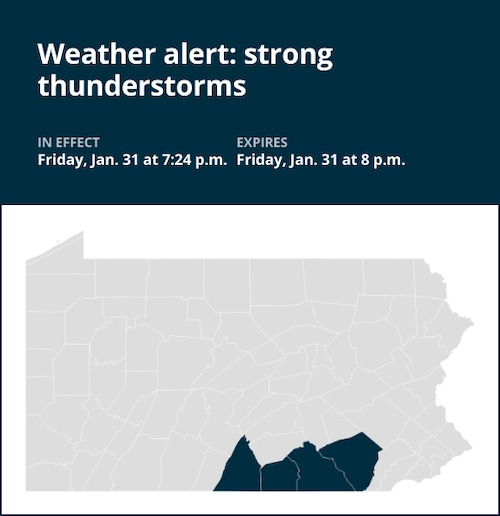At 7:24 p.m. on Friday, the National Weather Service issued a warning for Franklin, Adams, York, and Lancaster counties to experience heavy thunderstorms through 8 p.m.
Up to 40 mph wind gusts are possible for locals.
According to the meteorological service, “a strong thunderstorm was tracked by Doppler radar over Rouzerville at 7:23 p.m., moving east at 55 mph.” “Gusty winds could knock down tree limbs and blow around unsecured objects.”
The following places are affected by the alert: Biglerville, Loganville, Glen Rock, East York, Carroll Valley, Hallam, Spry, Washington Boro, Seven Valleys, Parkville, Red Lion, Lake Meade, Fawn Grove, Glenville, Cross Roads, Arendtsville, York Airport, Wayne Heights, Stonybrook-Wilshire, New Oxford, and New Oxford.
According to the weather service, “If you’re outside, think about taking cover inside a building.” Keep an eye on nearby radio stations and accessible television stations for more updates and any National Weather Service alerts as this storm may get stronger.
When lightning looms: Expert safety tips for thunderstorms
Approximately 25 million lightning strikes occur in the United States annually, most of which take place in the summer. The weather service reports that lightning is the cause of death for about 20 persons each year. As thunderstorms get closer, the risk of lightning increases; it peaks when the storm is directly overhead and then progressively decreases as it passes.
Think about the following suggestions to make sure you’re safe during a thunderstorm.:
Plan for lightning safety:
Indoor safety precautions:
Hold off till the all-clear:
When there is no indoor shelter:
Take these precautions to increase your safety if you are outside during a thunderstorm without access to inside shelter:
In conclusion, being alert and ready are your best defenses against lightning threats. You may put your safety first and drastically lower the likelihood of lightning-related mishaps by adhering to these rules.
Driving through downpours: Safety guidelines for wet roads
Safety comes first when there is a lot of rain. To avoid dangers and navigate wet roads, arm yourself with these weather service guidelines:
Watch out for swift water flow:
When it rains a lot, stay clear from parking or strolling near culverts or drainage ditches since the swift-moving water could carry you away.
Keep your distances from other vehicles safe:
In heavy rain, the two-second rule of following distance is your friend. To guarantee safe spacing under unfavorable circumstances, increase it to four seconds.
Reduce your speed and drive carefully:
Reduce your speed if it’s raining and the roads are wet. Reduce your speed gently by taking your foot off the accelerator. Never apply the brakes abruptly since this could cause the vehicle to slide.
Pick your lane carefully:
On multilane highways, stay in the middle lanes to reduce the chance of hydroplaning because water tends to pool in the outer lanes.
Visibility is important.
Turn on your headlights to improve visibility in severe rain. Rain-stained windows can hide cars in blind zones, so be cautious.
Be cautious on slick roads:
Roads are slickest during the first half-hour of rain because of a combination of rain, oil, and filth. Be especially careful during this time.
Stay a safe distance away from big cars:
Avoid following buses or big vehicles too closely. Their big tires produce a mist that blurs your eyesight. Additionally, be cautious when passing them; if you have to, pass swiftly and securely.
Be mindful of your wipers:
Visibility may be hampered by overloaded wiper blades. If the rain makes it very difficult to see, stop and wait for the weather to clear up. Look for cover in covered areas or rest areas.
If you can’t avoid the roadside, pull off as far as you can, ideally past the end of a guard rail, and wait for the storm to pass. To let other cars know where you are, turn on your emergency flashers and keep your headlights on.
You may greatly lower dangers and protect your health when it rains a lot by adhering to these safety precautions. To ensure a safe and sound voyage, keep yourself updated on weather conditions and follow local authorities’ instructions.
United Robots offers a service called Advance Local Weather Alerts that gathers the most recent information from the National Weather Service using machine learning.

